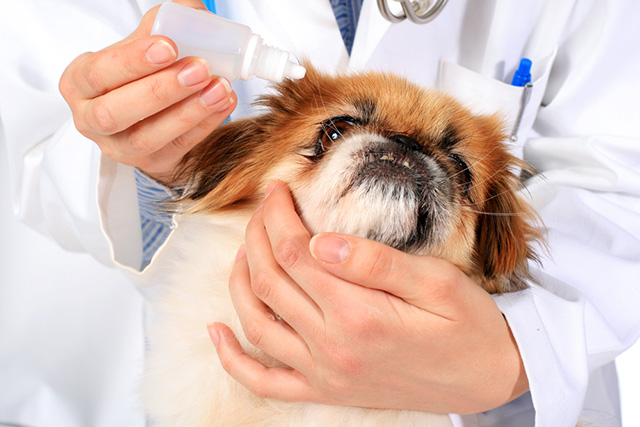A healthy dog’s eyes should be clear, bright and free from dirt, discharge and inflammation (redness) and the whites of the eye should be white not red or yellow.
What are the symptoms of eye problems in dogs?
Common symptoms of eye problems in dogs include:
- Red inner eyelids
- Matter ‘stuck’ on the surface or in the corners of the eye
- Cloudiness within the eyeball
- A dull eye surface
- The ‘third eyelid’ coming across the eye which looks like a pink curtain or fold of membrane
- Excessive tearing or unusual discharges
- Tear-stained fur around the eyes
Eye tests used to diagnose eye problems in dogs include:
- Fluorescein stain to identify the presence of corneal ulcers or defects in the surface of the eye
- Schirmer Tear Test to determine the level of tear production
- Ocular pressure to detect glaucoma
- Ophthalmoscope to see in the eye chamber
Common eye conditions in dogs
- Conjunctivitis is an inflammation of the membrane that covers the inner lining of the eyelids. This inflammation may extend to involve the white of the eye. It may be caused by allergies or by bacterial, fungal or viral infections.
- Keratoconjunctivitis Sicca (‘Dry eye’) occurs when the tear glands do not produce enough tears. This results in recurrent or chronic conjunctivitis – persistently sore eyes – and if left untreated, may eventually lead to blindness. The sooner your dog is treated the better the prognosis so get them to the vet sooner rather than later. Certain breeds, such as West Highland White Terriers, Cavalier King Charles and Cocker Spaniels, seem to be more prone to this problem, though any dog may be affected.
- Dogs which have been diagnosed with diabetes are a prime suspect if they have sore eyes.
- Corneal Ulceration can occur when the shiny surface of the cornea is scratched or damaged leading to defects in the eye which are not always visible to the naked eye. Ulceration can be dangerous as it could lead to complete perforation of the surface of the eye, therefore it is always important to get your dog to a vet if they have sore eyes.
- Epiphora occurs If your cat’s eyes constantly “weep”,due to an increased tear production or the normal tear flow through the tear duct is blocked. The fur around the eyes becomes “stained”due to the constant wetting effect which is often the sign that owners notice more often as a consequence of the problem.
- Cataracts & Glaucoma Dogs, just like humans, can have these serious eye diseases. Cataracts, which cloud the lens inside the eye can sometimes be seen in elderly dogs. A thorough evaluation by your veterinary surgeon is necessary as surgery is the only treatment.
- Glaucoma stems from too much pressure being exerted upon the eye’s interior as a result of a decrease in the amount of fluid draining from it. This increased pressure can damage the sensitive retina inside the eye which can lead to blindness.

How to put eye drops into your dog’s eyes
- In some cases you may need to muzzle your dog.
- Remove any discharge from around the eye with a cotton ball moistened with warm water.
- See the instructions on the bottle for dosage. Shake if necessary.
- Use one hand to hold the bottle between thumb and index finger and place the other under your dog’s jaw to support the head.
- Tilt the head back and, to prevent blinking, use your free fingers to hold the eyelids open.
- Hold the bottle close to the eye but DON’T touch the eye’s surface.
- Squeeze the drops onto the eye and once the drops are in, release the head.
- Your dog will blink, spreading the medication over the eye’s surface.
- Make a fuss or give your dog a treat after application
How to put eye ointment into your dog’s eyes
- In some cases you may need to muzzle your dog.
- Remove any discharge from around the eye with a cotton ball moistened with warm water.
- Check the instructions on the tube for dosage.
- Gently pull back upper and lower eyelids.
- Holding the tube parallel to the lower eyelid, squeeze the ointment on to its edge. DON’T let the tube touch the eye’s surface.
- Lightly massage upper and lower eyelids together to spread the medication.
- Release the head. Let your dog blink.
- Make a fuss or give your dog a treat after application

